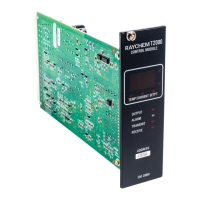nVent.com | 47
SECTION 6 CONTROL MODULE TROUBLESHOOTING
6.1 OPERATOR CHECKS
IMPORTANT: If the control module does not operate properly and is being returned to
nVentforservice,informationmustbeprovidedastowhytheunitwasremovedfromservice.
Contact nVent for a Return Authorization form and number prior to returning any units
forrepair.
Upon receipt of the control module, or to check the control module for an indication of
normaloperation,followtheoperationalproceduresshownbelow.Theseproceduresare
designed to familiarize the operator with the control module and to provide an understanding
of its operation.
In order to determine if a fault is associated with the heat tracing, wiring or the control module,
it will be necessary to troubleshoot the wiring and heating circuit. If the fault remains, remove
power from the control module and exchange it with another control module. This may require
some reprogramming of the new control module. Refer to the following sections for the
appropriate topic.
If the fault clears, exchange the control module on another heating circuit to determine if the
fault moves with the control module. If the fault moves with the control module, verify that the
control module has been configured correctly for the application. If the configuration is correct
it may be necessary to return the control module to nVent for evaluation.
6.1.1 GETTING STARTED
In order to access the parameters and data of the CM 2000/CM 2000+ control module use any
of the external upstream programming devices mentioned in Section 1.3. See the appropriate
manual for operational details.
6.2 COMMON PROBLEM AREAS
The control module may be used as an effective trouble-shooting tool to pinpoint problem
areas of heating circuits. The following sections describe a few of the more common problem
areas, their symptoms, and parameters to check to determine the actual faulty portion of the
heating circuit.
6.2.1 RTDS
RTD failures after installation can generally be attributed to incorrect wiring or improper
installation of the sensor. Troubleshooting of these failures is a very simple procedure if the
proper steps are undertaken in the correct order. Some specific RTD problems and the correct
methods for troubleshooting are outlined as follows.
1. TS Failure Alarm(s)
If the control module indicates a failure of an RTD:
• Ensure that the RTD is a 3-wire 100 ohm platinum type.
Turn the power to the CONTROL MODULE off before proceeding!
• Disconnect the RTD wiring from the input terminals.
• Measure the RTD’s resistance between the source and sense leads at the control module
(itshouldnotexceed40W).NotethattheusualcolorcodesforthesewiresareWhite-White
or White-Black. Excessive lead resistance will cause a TS FAILURE ALARM and must be
corrected. Look for loose terminals, excessive lead length, or insufficient extension wire
gauge and correct as necessary.
• Measure the RTD’s resistance between the source or sense lead and the common lead of
the RTD at the control module (resistance should be between 60 & 330 W depending on the
temperature and the lead resistance. See Appendix F. The usual color code for the source
lead is Red, and the source and sense leads are usually White or Black.

